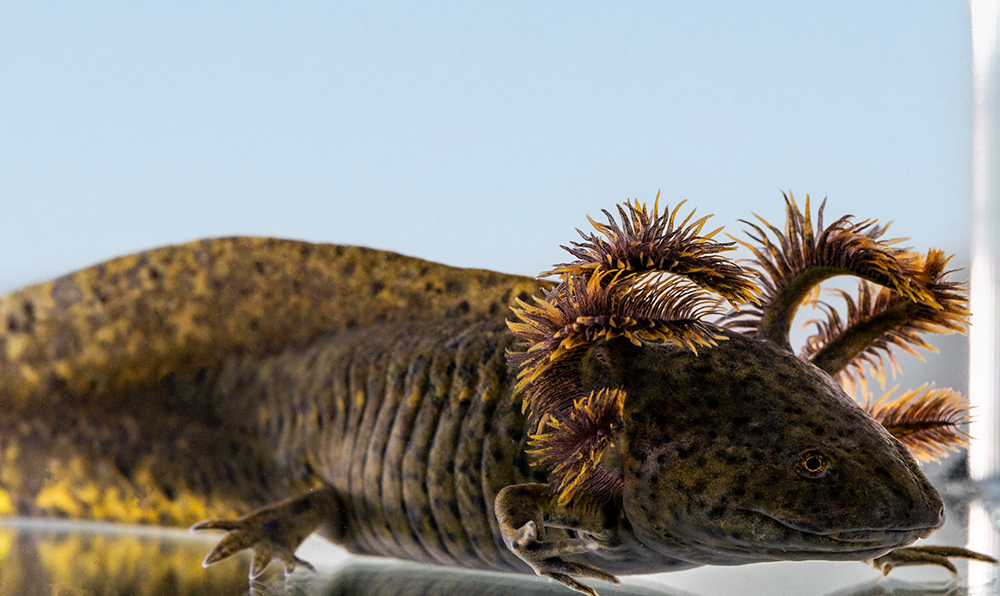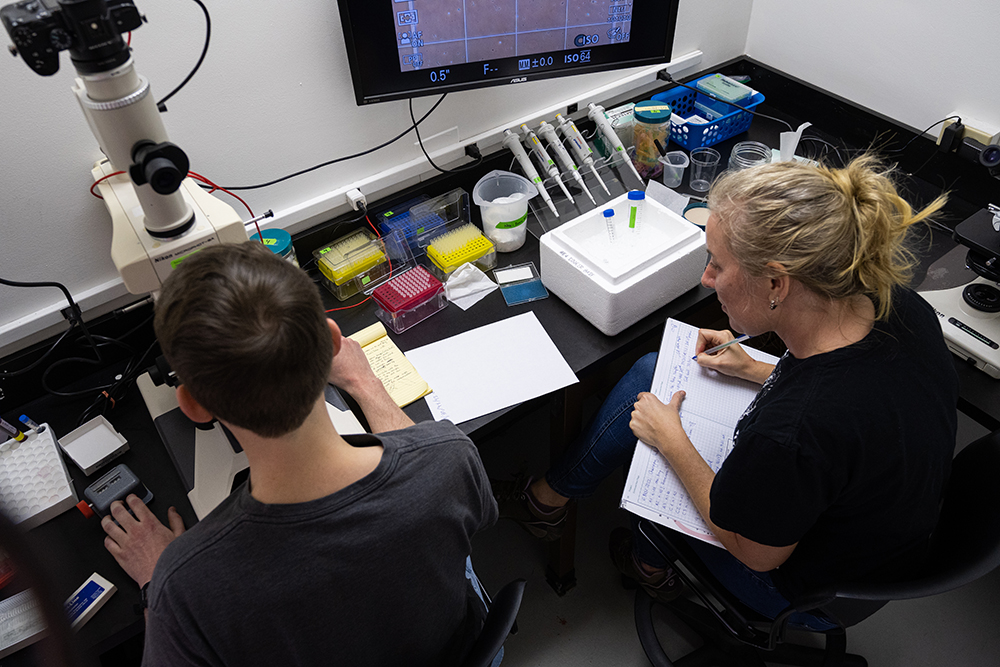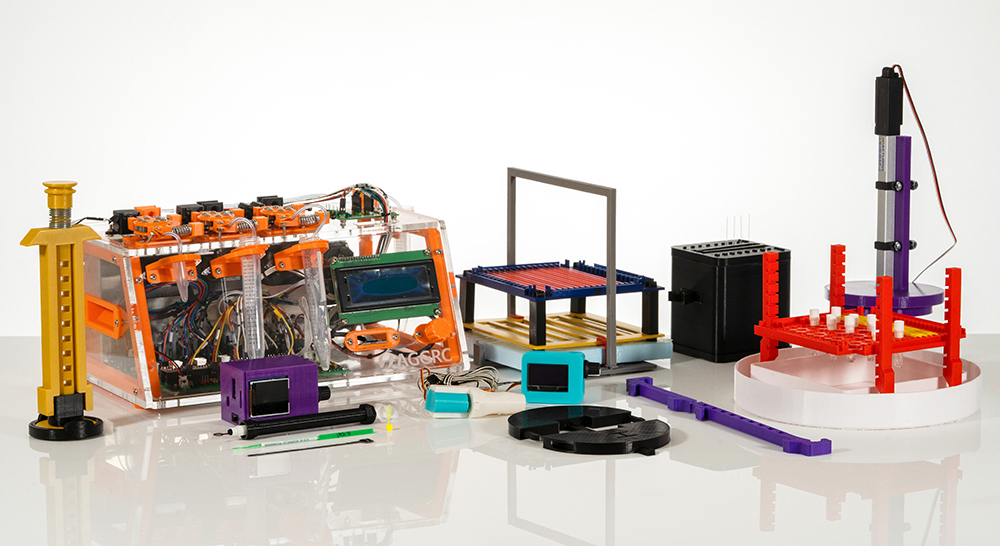An Interdisciplinary Team Assembled to Preserve Aquatic Genetic Resources and to Develop Capacity Building at Resource Center Cryo-Repositories
Researchers use a diverse array of aquatic organisms—such as fish, amphibians, and invertebrates—to explore various biological questions. Some of these organisms have been genetically modified to create models (i.e., genetic lines) to better understand the different aspects of the pathobiology of human diseases. Yet as more and more genetic lines are developed for research, maintaining them in animal facilities poses significant challenges related to husbandry and infrastructure, biosafety, and financial sustainability. A strategy to address these challenges lies in cryopreservation—an approach that is used to freeze biological materials for extended periods.
Cryopreservation of germplasm (e.g., sperm, which comprises half of an organism’s genetic material) allows researchers to preserve valuable genetic information, but different challenges exist across species. The Aquatic Germplasm and Genetic Resources Center (AGGRC), located at the Louisiana State University Agricultural Center, has been working since 2015 to make cryopreservation feasible and accessible to researchers using aquatic species across the world. The AGGRC has received support from ORIP (R24OD010441 and R24OD028443) in this effort.
Dr. Jack Koch, a postdoctoral researcher at the AGGRC, underscored the importance of safeguarding prior investments in genetic resources. “There are many aquatic resource centers around the world. In those facilities, imagine that there are thousands of tanks, each with a different genetic line. Let’s imagine we have to take care of all of those animals,” Dr. Koch reflected. “But if we cryopreserve lines that we’re not using at the time, we’re saving time, money, and resources.” Dr. Zoltan Varga, Director of the Zebrafish International Resource Center (ZIRC), added, “Reduction of live animals is a key component of the 3 Rs—replacement, reduction and refinement—for animal welfare in research facilities because it frees up resources and time for optimized care and health monitoring of live stocks in animal colonies.”

During the past decade, the AGGRC has collaborated with ZIRC and the Xiphophorus Genetic Stock Center (swordtails and platyfish), both ORIP-supported resources, to develop repositories for cryopreserved sperm from research lines. Dr. Varga underscored the value of ZIRC’s collaboration with the AGGRC, stating, “Without the AGGRC team, we would be nowhere with cryopreservation. Today, it [cryopreservation] is the stock management tool at ZIRC and eliminates shipping and animal maintenance costs for the biomedical community that can be directed to research activities instead.”
Building on this success, the AGGRC has begun to expand its efforts to develop cryopreservation capacity building at other ORIP-supported aquatic research models, such as at the Ambystoma Genetic Stock Center (axolotls), National Xenopus Resource (frogs), and National Resource for Aplysia (sea slugs). These resource centers represent some of the largest repositories of living genetic stocks available to the research community (Figure 1), and the AGGRC is working to unite the centers in a multi-resource collaborative effort. Dr. Varga reflected, “We are glad that aspects of the AGGRC–ZIRC collaboration now serve as a template for other stock centers.”
Dr. Terrence Tiersch, Director of the AGGRC, explained that the group employs a user-centric approach to provide services to the research community. The AGGRC works closely with resource centers to establish their own germplasm repository capabilities with scalable and reproducible systems (Figure 2). “We serve as a hub, and the centers are the spokes. We’re working with each center to develop what they need and then working to get that into their hands—from protocols to technologies to training programs, whatever it takes,” Dr. Tiersch explained. “This allows us to magnify our efforts through the existing centers, where they help each other and serve their own communities. It’s like a fractal—a story within a story within a story.”

With the support of the AGGRC, the resource centers are learning techniques to store germplasm samples. This work benefits greatly from a close collaboration with the U.S. Department of Agriculture’s National Animal Germplasm Program in Fort Collins, Colorado, a leading animal germplasm repository that is providing backup cryopreservation for ORIP-supported resources.
The AGGRC follows a philosophy of open science and is creating tools and resources that are available freely to the research community to assist them with the implementation of cryopreservation efforts at the laboratory bench. The team is developing and publishing digital files for hardware (e.g., tools, devices) that can be constructed by users at their home institutions via 3D printing and other technologies that have become broadly accessible in recent years (Figure 3). All of these devices are intended to be fabricated by users, and design files and instructions are made available on the NIH 3D Print Exchange and the AGGRC website.
Dr. Yue Liu, Assistant Director of the AGGRC, explained that the concept of open hardware helps foster user engagement and will promote continued improvement of the hardware over time. “This is the spark of this movement, of forming an open-hardware community by working with others,” Dr. Liu reflected. “10 or 20 years down the road, this will be the future. Because this is what scientists do; we all must work together to make a better world. We are doing this through open hardware, and we are trying to push this movement forward.” Importantly, the AGGRC encourages the use of open-source technologies with the national resource centers. The National Xenopus Resource and ZIRC, for example, are actively testing AGGRC-developed open hardware and now are developing and 3D-printing husbandry tools of their own.

Due to the remarkable biological diversity of aquatic organisms, each species poses unique considerations for cryopreservation. For example, the axolotl has one of the largest sperm sizes known, whereas sperm of swordtails are among the smallest. Further, Aplysia (i.e., sea slugs) require cryopreservation of embryos that are contained within complicated multi-layered structures. The AGGRC has assembled an interdisciplinary team to take on this multi-faceted effort.
The center can operate at an industrial scale, with the capacity to process millions of samples per month. The team comprises experts from many areas, including engineering, biological sciences, veterinary medicine, natural history, and agricultural economics, as well as photography, videography, art, and graphic design. The AGGRC fosters cross-training and communication across disciplines, and students from different academic backgrounds are encouraged to take on active roles, including in animal husbandry, graphic design, and 3D printing.
Dr. Tiersch emphasized the unique benefits of this approach, which promotes a culture of learning and success within the team. Ultimately, he emphasized, the team members must learn to engage with and learn from one another. “People have a lot of room to grow when they’re not put into a column—when they’re not told, for example, ‘You’re a student; you can’t do that,’” he reflected. Dr. Tiersch added that an emphasis on interdisciplinary collaboration also provides a direct path to move from ideas to research to real-world application, all within a single location. He remarked, “It’s a really interesting culture that arises from being truly interdisciplinary. It’s exciting to be in an environment where great ideas are never in short supply.”
ORIP advances the NIH mission by supporting infrastructure for innovation. For more information on ORIP’s support for cryopreservation of animal resources, visit orip.nih.gov/sites/default/files/ORIP-Cryopreservation-Fact-Sheet.pdf.



